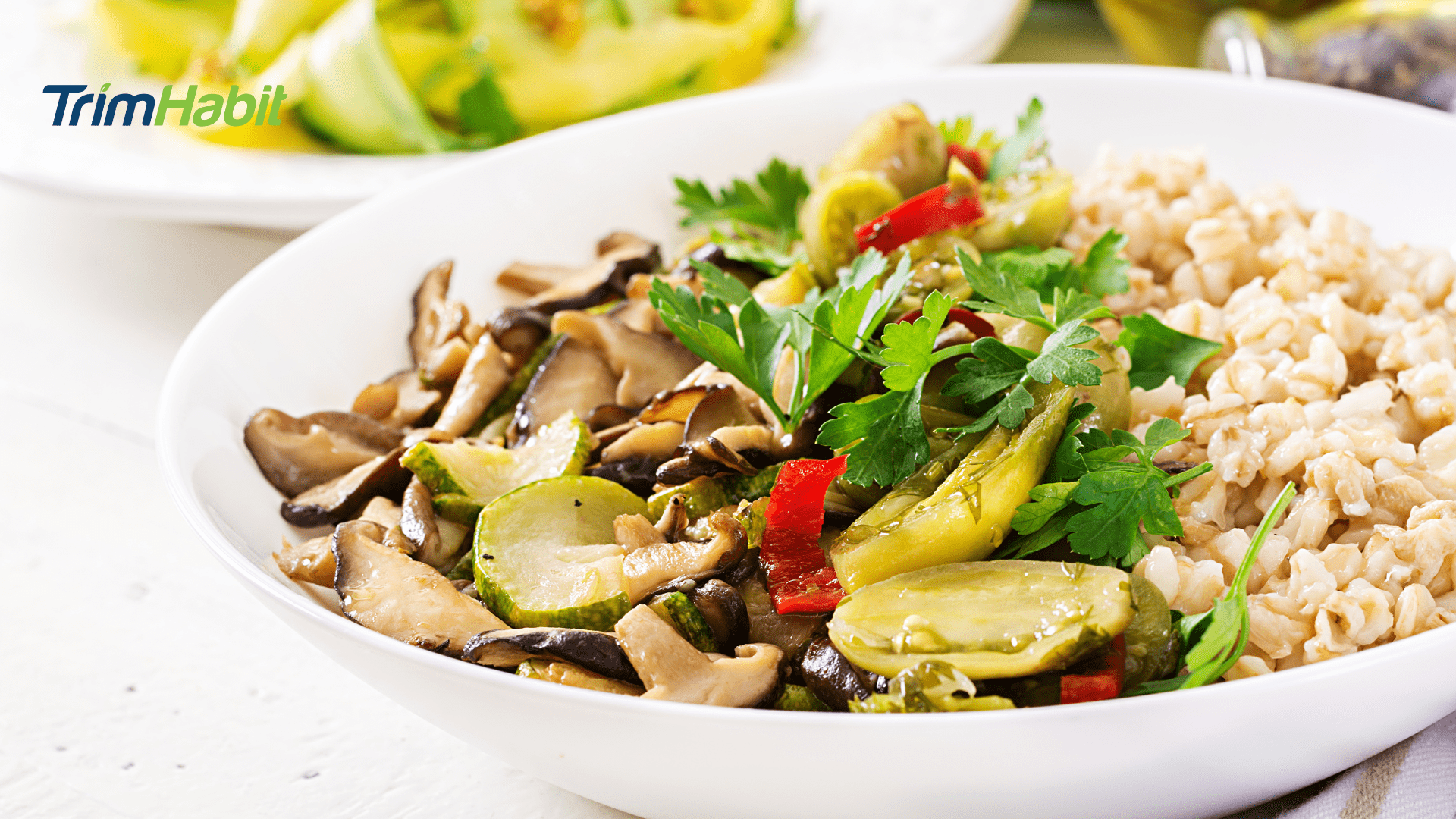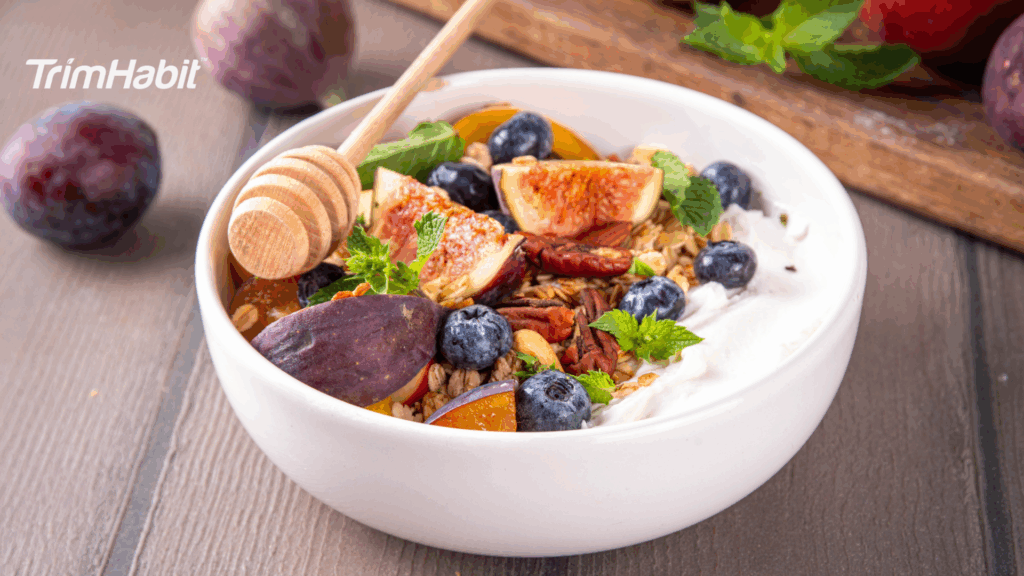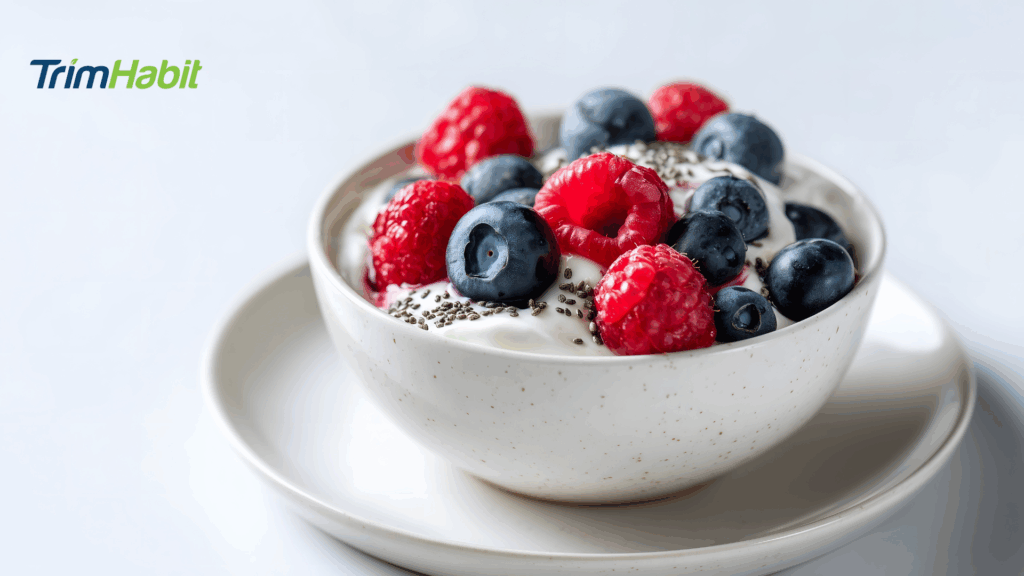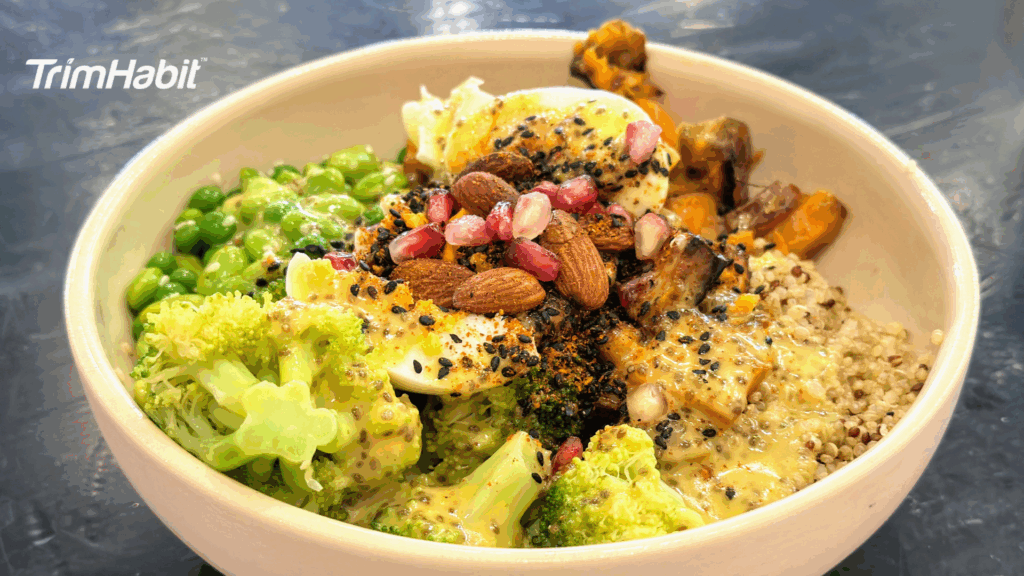Starting semaglutide for weight management or blood sugar control is a major step toward better health, but it also requires smart eating choices. If you follow a vegetarian lifestyle, building balanced and satisfying meals can feel even more difficult as your appetite decreases and digestion slows.
The good news? A well-planned vegetarian diet can work seamlessly with semaglutide. When done right, it can help support your energy, digestion, and long-term progress.
In this article you’ll find practical vegetarian meal plan ideas while using semaglutide that prioritize fiber, protein, and nutrient density so you stay full, nourished, and on track with your goals.
Semaglutide Overview
Semaglutide is a prescription medication originally developed to help manage type 2 diabetes, but it has since become widely used as a tool for weight loss and broader metabolic support. Its effectiveness stems from its ability to mimic a naturally occurring hormone in the body called GLP-1, or glucagon-like peptide-1. This hormone plays a key role in blood sugar regulation by stimulating insulin release, reducing glucagon secretion, and slowing the rate at which food leaves the stomach. These combined effects help lower blood sugar levels after meals, prevent spikes, and reduce appetite1. As a result, semaglutide not only helps control blood glucose in individuals with diabetes but also supports sustainable weight loss in people with or without diabetes by promoting satiety and decreasing food intake.
Key Nutritional Considerations For Vegetarians On Semaglutide
While semaglutide helps reduce appetite and promote weight loss, vegetarians must ensure their meals remain nutritionally balanced, satisfying, and gentle on digestion. Developing healthy eating habits, such as choosing nutrient-dense foods and making positive lifestyle modifications, can help maximize the benefits of semaglutide. Here’s what to focus on:
1. Prioritize High-Fiber Plant Foods
Semaglutide slows digestion, and fiber enhances satiety and digestive regularity. Vegetarian diets are naturally fiber-rich—make sure to include a variety:
Great picks: Lentils, chickpeas, black beans, quinoa, chia seeds, flaxseeds, leafy greens, oats, and a wide range of fruits and vegetables.
Fruits and vegetables are also excellent sources of essential vitamins, supporting overall health as part of a balanced diet.
2. Get Enough Protein
Vegetarian protein sources are essential to preserve muscle mass and keep you full, especially when you eat less due to reduced appetite. Maintaining adequate protein intake supports muscle maintenance and enhances satiety during weight loss.
Smart options: Choose lean protein sources suitable for vegetarians, such as tofu, tempeh, edamame, seitan, Greek yogurt, cottage cheese, legumes, and protein-fortified plant milks.
3. Watch for Nutrient Gaps
Vegetarians are at higher risk of certain deficiencies, which semaglutide’s appetite suppression might worsen if intake becomes too limited. Focusing on nutrient-dense foods can help prevent deficiencies and support your health.
Key nutrients to monitor:
- Vitamin B12: fortified foods or supplements
- Iron: beans, spinach, fortified cereals + pair with vitamin C
- Calcium: fortified plant milks, leafy greens
- Omega-3s: walnuts, flaxseeds, chia, algae oil supplements
- Zinc: pumpkin seeds, whole grains, legumes
4. Eat Small, Balanced Meals
Semaglutide may make large meals uncomfortable. Instead:
- Focus on smaller portions with balanced macros (protein + fiber + healthy fats).
- Snack smart: Try hummus with vegetables, vegetable sticks with a nutritious dip, Greek yogurt with berries, or a protein smoothie.
It’s important to eat daily, even if portions are small, to maintain balanced nutrition and support your health goals.
5. Stay Hydrated
Semaglutide can increase the risk of dehydration. Aim for at least 8 cups of water daily, especially when eating high-fiber foods.
Vegetarian Meal Plan Ideas While Using Semaglutide
If you’re following a vegetarian diet while using semaglutide, it’s important to create meal plans that are satisfying, nutrient-dense, and easy to digest. Because semaglutide reduces appetite and alters digestion, eating smaller, strategically balanced meals can help support your energy, weight goals, and nutritional needs.
Below is a sample meal plan for vegetarians, with ideas for each meal of the day. This sample meal plan is designed to offer adequate protein, fiber, healthy fats, and essential nutrients without overwhelming your appetite.
Breakfast Options
Start the day with a protein-rich, fiber-filled meal to promote satiety and stabilize blood sugar.
1. Greek Yogurt Power Bowl
- Plain, low-fat Greek yogurt (¾ to 1 cup) or plain yogurt as an alternative
- Topped with a tablespoon of chia seeds, a small handful of berries (blueberries or raspberries), and a sprinkle of slivered almonds
- Optional drizzle of honey or cinnamon for flavor
2. Savory Tofu Scramble
- Crumbled tofu sautéed with olive oil, turmeric, garlic, spinach, mushrooms, and diced bell peppers
- Served with one slice of whole grain toast or ½ cup of cooked quinoa
- Top with fresh herbs like parsley or chives for added flavor and nutrition
3. High-Protein Oatmeal
- Cooked rolled oats with unsweetened almond milk
- Stir in 1 tablespoon ground flaxseed and one scoop of plant-based protein powder
- Add sliced banana or apple for natural sweetness
- Whole grains like oats provide sustained energy to help prevent blood sugar spikes and keep you full longer
4. Breakfast Wrap with Whole Grain Tortilla
- Scrambled eggs or tofu, sautéed spinach, and diced tomatoes wrapped in a whole grain tortilla
- Add a spoonful of salsa or fresh herbs for extra flavor
Lunch Options
Choose meals that provide a good balance of plant protein, fiber, and healthy fats to keep you feeling full without overeating. These lunch options also help support adequate protein intake for muscle maintenance and satiety.
1. Lentil and Quinoa Salad
- Cooked green or brown lentils and quinoa served over a bed of mixed greens, mixed with chopped cherry tomatoes, cucumbers, red onion, and baby spinach
- Dressed with olive oil, lemon juice, and a pinch of sea salt
- Optional: top with crumbled feta cheese, avocado slices, or a sprinkle of unsalted nuts for added crunch and nutrition
- Enjoy with a side of whole grain crackers for extra fiber
2. Chickpea Salad Sandwich
- Mashed chickpeas mixed with tahini or vegan mayo, diced celery, red onion, lemon juice, and mustard
- Served on whole grain bread or in a lettuce wrap
- Side of carrot sticks or apple slices for a fresh, nutritious addition
3. Vegetable Stir-Fry with Tempeh
- Sautéed tempeh with a variety of vegetables such as broccoli, snap peas, bell peppers, and carrots
- Flavored with low-sodium soy sauce or coconut aminos and fresh ginger
- Served over a small portion (½ cup) of brown rice or cauliflower rice
Dinner Options
Evening meals should be nourishing yet gentle on the stomach. Avoid very large or heavy meals, especially close to bedtime. These dinner options support weight loss and help you lose weight by promoting a reduced calorie intake. Adjust portion sizes based on your body weight for optimal results.
1. Stuffed Sweet Potato
- Roasted or steamed sweet potato filled with black beans, sautéed kale, avocado, and salsa
- Garnished with fresh lime juice and a sprinkle of pumpkin seeds
- Serve with a side of steamed broccoli for added fiber and nutrients
2. Zucchini Noodles with Pesto and White Beans
- Spiralized zucchini tossed with homemade or store-bought pesto
- Add a serving of cannellini or great northern beans
- Optional: sprinkle with nutritional yeast or parmesan cheese for added flavor
- Include sliced bell pepper for extra crunch and vitamins
3. Mild Vegetable and Tofu Curry
- Tofu cubes simmered in a coconut milk curry sauce with vegetables such as spinach, eggplant, and bell peppers
- Served with ½ cup of cooked jasmine or basmati rice
- Garnished with cilantro and a squeeze of lime
- Use olive oil or avocado oil in cooking to incorporate healthy unsaturated fats
Smart Snack Ideas
Snacking may not always be necessary on semaglutide, but when you feel hungry between meals, choose snacks that contribute to your nutritional goals.
- Sliced apple with one tablespoon of almond or peanut butter
- Apple slices with unsalted nuts
- Roasted chickpeas or edamame
- Vegetable sticks with hummus
- Cottage cheese with cherry tomatoes and cracked black pepper
- Plain yogurt with fresh fruit or a sprinkle of seeds
- Whole grain crackers with low-fat cheese or nut butter
- Air-popped popcorn seasoned with your favorite spices
- Protein smoothie made with almond milk, frozen berries, spinach, and a scoop of pea protein powder
- A handful of trail mix with unsalted nuts, seeds, and dried fruit (in moderation)
Tips for Success
- Portion control matters: Reduced appetite means you’ll be satisfied with smaller meals. Use smaller plates or bowls to help prevent overeating.
- Meal prep with intention: Prepare meals and snacks in advance to reduce decision fatigue and ensure balanced intake.
- Stay consistent with your weight loss efforts: Maintain healthy habits and dietary strategies over time to support your goals.
- Focus on whole foods: Choose minimally processed plant-based foods to maximize nutrients in every bite.
- Listen to your body: If you’re not hungry, it’s okay to skip or reduce a meal, but be mindful not to skip essential nutrients.
Tips For Meal Prep Success
Meal prepping is one of the best strategies to stay consistent, reduce food waste, and make healthy eating easier, especially while on semaglutide, when appetite is lower and food choices must be intentional. Using meal plans can help you organize your meal prep and ensure a structured approach to your weekly eating. When selecting ingredients, focus on foods to eat that are nutrient-dense, support weight management, and are gentle on digestion. These tips will help you prep balanced meals that are portion-aware and aligned with your health goals.
Plan Smaller, Nutrient-Packed Meals
Since you’re likely eating less on semaglutide, each meal should deliver essential nutrients in a smaller volume.
- Focus on meals that combine plant protein, fiber, and healthy fats and include nutrient-dense foods such as fruits, vegetables, lean proteins, and whole grains.
- Use meal prep containers with compartments to help balance portions.
- Aim for meals around 250–400 calories for most individuals, unless otherwise advised.
Choose Easy-to-Digest Ingredients
Semaglutide slows down digestion, so avoid overly rich or greasy meals.
- Prioritize cooked vegetables over raw when prepping in bulk—they’re easier on the stomach.
- Include whole grains like quinoa, brown rice, or oats for long-lasting fullness.
- Avoid high-fat sauces or ultra-processed foods, which can trigger nausea.
Batch Cook Core Ingredients
Make your prep time efficient by cooking ingredients you can mix and match throughout the week.
- Proteins: Cook a batch of lentils, chickpeas, tofu, or tempeh.
- Grains: Prepare 2–3 cups of quinoa, brown rice, or farro.
- Vegetables: Roast a tray of mixed veggies (sweet potatoes, zucchini, bell peppers, carrots).
Store them separately to combine them into fresh bowls, wraps, or salads.
Prep Grab-and-Go Snacks and Mini Meals
Some days, you may not feel like eating much. Small, pre-portioned snacks ensure you meet your nutrition needs without forcing full meals.
- Single-serve containers of Greek yogurt, plain yogurt, hummus, or cottage cheese
- Snack boxes with unsalted nuts, whole grain crackers, fruit, or roasted edamame
- Smoothie packs (pre-measured fruit, greens, protein powder, stored in freezer bags)
Label and Date Everything
With smaller portions and frequent prep, it’s easy to lose track of what you’ve made.
- Use clear labels with the prep date and contents.
- Rotate meals to avoid spoilage and food fatigue.
Freeze Leftovers Wisely
If you’re eating less than usual, you might not finish everything in a few days. Freezing is your friend.
- Freeze soups, stews, and veggie curries in single-serve containers.
- Make sure to cool food completely before freezing to avoid ice crystals.
Stay Flexible and Listen to Your Body
Your hunger levels may vary day to day. Avoid rigid eating schedules.
- Keep smaller portions on hand to allow you to eat only what you need.
- If you’re not hungry at your usual mealtime, it’s better to delay your meal rather than skip it entirely. Just make sure you stay hydrated and still get enough nutrients throughout the day to support your energy and recovery.
Meal Prep Tools That Help
- Glass containers with dividers
- Portion control containers or a kitchen scale
- Insulated lunch bags for easy transport
- Mason jars for overnight oats or layered salads
- Freezer-safe containers for make-ahead meals
Meal prep isn’t about being perfect. It’s about being prepared. When you’re on semaglutide, your energy and motivation around food can change. Having a plan in place reduces stress, supports your progress, and helps you nourish your body even on days when your appetite is low.
Foods To Limit Or Watch
Semaglutide changes how your body digests food and can make you more sensitive to certain ingredients. Because of this, some foods may be harder to tolerate and can trigger side effects like nausea, bloating, or low energy. Avoiding certain items can help you feel more comfortable and support better results.
Here are the main categories to keep an eye on:
Fried and Greasy Foods
Fried foods, which are high in unhealthy fats, can be harder to digest and may worsen nausea or stomach upset, especially early in treatment.
- Examples: French fries, fried tofu, samosas, deep-fried mock meats
- Better alternatives: Baked or air-fried vegetables, pan-seared tofu, or oven-roasted snacks
High-Sugar Foods and Refined Carbs
Simple sugars can cause blood sugar spikes and may leave you feeling sluggish or hungrier shortly after.
- Examples: White bread, pastries, cookies, sugary cereals, sweetened drinks, sugary drinks
- Better alternatives: Whole grains (quinoa, oats, brown rice), fruits, and unsweetened plant milks
Large Meals or Buffets
Overeating can lead to discomfort, bloating, or nausea when taking semaglutide.
- Tips: Stick to small plates, eat slowly, and stop when comfortably full even if food is left on the plate.
Ultra-Processed Vegetarian Foods
Highly processed meat substitutes and packaged snacks may be convenient, but often contain excess sodium, refined oils, and additives that don’t support overall health.
- Examples: Store-bought veggie nuggets, soy-based hot dogs, fake meats with long ingredient lists
- Better alternatives: Homemade bean patties, lentil loaf, or seasoned tofu or tempeh
Carbonated Beverages
Bubbly drinks can increase gas and bloating, which semaglutide’s slowing of digestion may amplify.
- Examples: Soda, sparkling water, kombucha in excess
- Better alternatives: Still water, infused water with lemon or cucumber, herbal teas
Artificial Sweeteners (in excess)
Some people experience digestive upset from sugar alcohols or artificial sweeteners found in “diet” foods.
- Examples: Products containing sorbitol, xylitol, or sucralose
- Tip: Read labels and test your tolerance—some may be fine in small amounts, others not.
Alcohol
Alcohol can irritate the stomach, contribute to nausea, and interfere with blood sugar control.
- Recommendation: Limit intake or avoid, especially during the early weeks of semaglutide use.
General Guidelines
- When in doubt, choose whole, minimally processed foods and prioritize healthy foods to support your weight loss efforts.
- Keep meals simple, balanced, and portion-conscious.
- Introduce new foods gradually and monitor your body’s response.
Final Thoughts
Following a vegetarian diet while using semaglutide doesn’t have to be complicated, but it does require intention. With reduced appetite and slowed digestion, every meal becomes an opportunity to nourish your body effectively and support your weight or blood sugar goals.
You can stay full, energized, and well-balanced even while eating less by focusing on high-fiber vegetables, quality vegetarian proteins, and essential nutrients like B12, iron, and omega-3s. Smart meal planning, mindful portions, and simple prep habits can make your experience with semaglutide easier and more effective.
Remember: your nutrition should work with the medication, not against it. Keep meals simple, whole-food-based, and tailored to how your body feels. Whether in the early stages of semaglutide use or well into your journey, a smart, satisfying vegetarian approach can help you feel nourished, not restricted.









